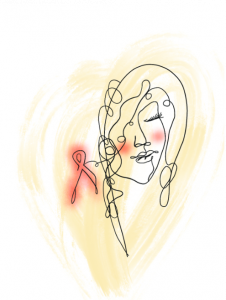Written by: Loulou Cai, PhD Candidate, Côté Lab

Edited by: Marie-Soleil Smith, PhD Candidate, Côté Lab

Image from CATIE and the BCC3 team.
It is widely known that on average, women have longer lifespans than men. However, this is not the case for women living with HIV (WLWH) in Canada, who have shorter lifespans than men living with HIV. One important piece of the puzzle that may help to explain this phenomenon relates to chronic pain. Chronic pain, especially among WLWH, can significantly impact medication adherence, retention in care, mobility, mental/emotional well-being, and quality of life. The etiology of pain in people living with HIV is poorly understood, but likely multifactorial, partly related to side effects from early HIV drugs1. Several reviews have described the prevalence and risk factors in pain for people living with HIV2-5. However, there are few studies that focus on women specifically, even though data suggest that women in the general population are more likely to experience chronic pain as compared to men. A recent publication by members of the Côté Lab, “Global Prevalence of Chronic Pain in Women with HIV: A Systematic Review and Meta-analysis”, explores articles published in the last 40 years that investigated pain in WLWH.
Overall, 35 studies were included in the meta-analysis, which spanned 22 countries and included 19,966 participants. The most commonly reported type of pain was peripheral neuropathy (n=22), followed by widespread or other types of chronic pain, including fibromyalgia and headache. The pooled prevalence of chronic pain across all 35 studies was 31.2%, with the lowest reported at 4.0% and the highest at 84.1%. There was considerable heterogeneity, highlighting methodological and demographic differences within the analyzed studies. Three of the studies compared the prevalence of chronic pain between WLWH and HIV-negative controls, where WLWH had significantly higher levels of pain compared to controls.

Image from CATIE and the BCC3 team.
The global prevalence of pain found in this study (31.2%) is similar to the prevalence of chronic pain among HIV-negative persons in middle- and low-income countries (33%), but higher than the prevalence in the United States (20.4%). This article also highlights major gaps in the literature, including for example, studies of pain that is more specific to women, such as those with breast, pelvic, vaginal, and/or menstrual pain. In addition, only one article discussed pain severity, which is a critical component of understanding the pain experience and its effect on the quality of life. Overall, the results suggest that chronic pain is highly prevalent among WLWH and warrants regular assessment at healthcare visits. Lastly, they echo the recommendations of the Global Task Force for Chronic Pain in People With HIV, which include the need for further research on effective methods of pain management, as well as the etiology of chronic pain. In summary, to reiterate the authors’ final thoughts, “We therefore wish to emphasize the importance of sharing research results about chronic pain with women with HIV to validate their experiences, increase opportunities for meaningful dialogue, identify knowledge gaps, and encourage co-learning between clinical, academic, and community partners.”
Link to the paper: https://academic.oup.com/ofid/article/10/8/ofad350/7224781
References:
- Addis, Dylan R., Jennifer J. DeBerry, and Saurabh Aggarwal. “Chronic pain in HIV.” Molecular pain 16 (2020): 1744806920927276.
- Surratt, Hilary L., et al. “Pain treatment and antiretroviral medication adherence among vulnerable HIV-positive patients.” AIDS patient care and STDs4 (2015): 186-192.
- Merlin, Jessica S et al. “Pain, mood, and substance abuse in HIV: implications for clinic visit utilization, antiretroviral therapy adherence, and virologic failure.” Journal of acquired immune deficiency syndromes (1999) 61,2 (2012): 164-70.
- Miaskowski, Christine, et al. “Occurrence and characteristics of chronic pain in a community-based cohort of indigent adults living with HIV infection.” The Journal of Pain9 (2011): 1004-1016
- Mwesiga, Emmanuel K., et al. “Classification and description of chronic pain among HIV positive patients in Uganda.” African Health Sciences2 (2019): 1978-1987.


